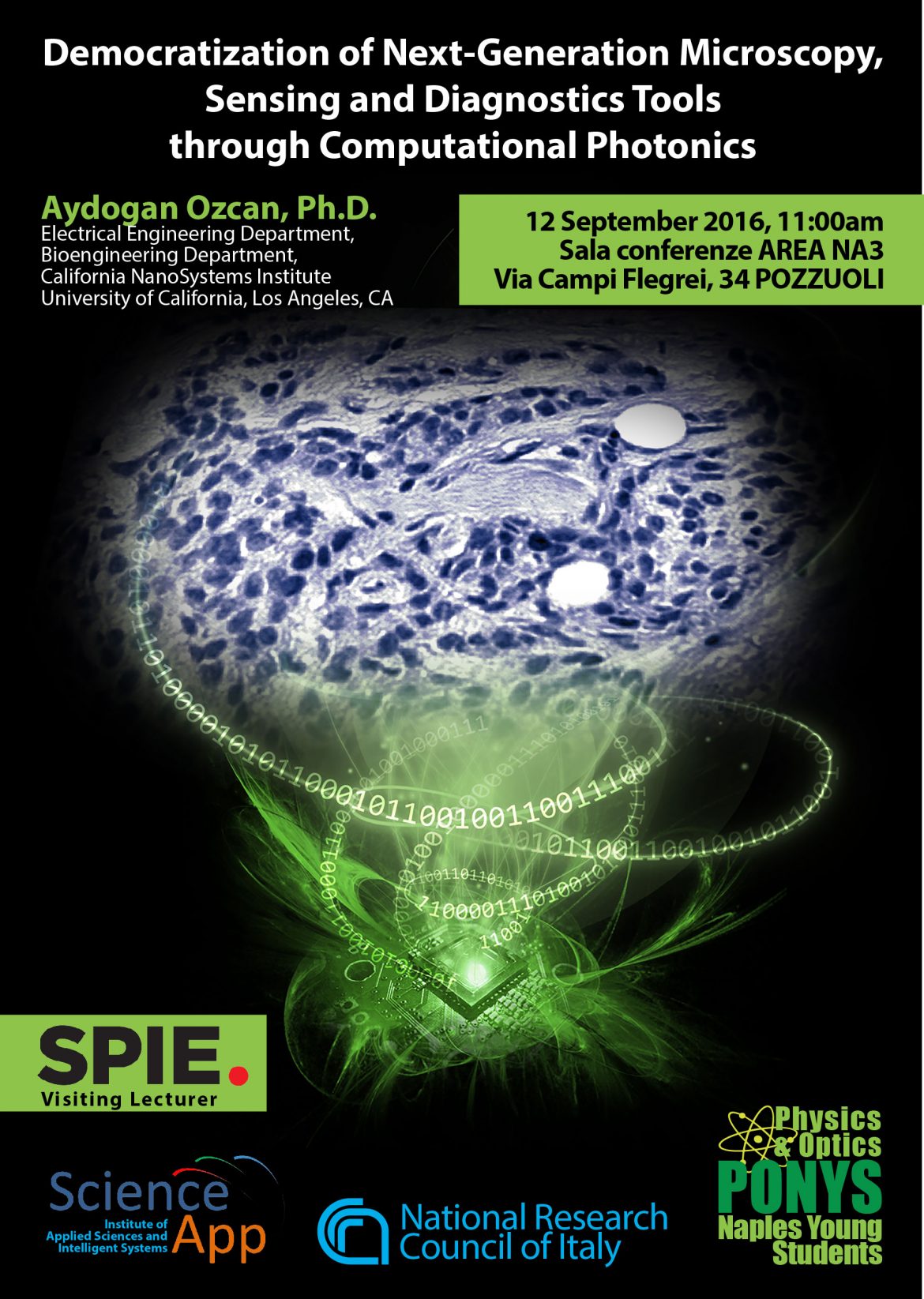On Monday 12th September 2016, Prof. Aydogan Ozcan from University of California will give a lecture on “Democratization of Next-Generation Microscopy, Sensing and Diagnostics Tools through Computational Photonics”. The seminar is scheduled at 11am in Sala Conferenze AREA NA3. It is a joint activity beetween the Istitute of Applied Science and Intelligent Systems (ISASI) and the Physics and Optics Naples Young Student (PONYS) association, who invited Prof. Ozcan in the framework of the SPIE Visiting Lecturer Program.
Dr. Aydogan Ozcan received his Ph.D. degree at Stanford University Electrical Engineering Department. After a short post-doctoral fellowship at Stanford University, he was appointed as a research faculty at Harvard Medical School, Wellman Center for Photomedicine in 2006. Dr. Ozcan joined UCLA in the summer of 2007 as an Assistant Professor, and was promoted to Associate and Full Professor ranks in 2011 and 2013, respectively. He is currently the Chancellor’s Professor at UCLA and an HHMI Professor with the Howard Hughes Medical Institute, leading the Bio- and Nano-Photonics Laboratory at UCLA Electrical Engineering and Bioengineering Departments, and is also the Associate Director of the California NanoSystems Institute (CNSI) at UCLA.
ABSTRACT
My research focuses on the use of computation/algorithms to create new optical microscopy, sensing, and diagnostic techniques, significantly improving existing tools for probing micro- and nano-objects while also simplifying the designs of these analysis tools. In this presentation, I will introduce a new set of computational microscopes which use lens-free on-chip imaging to replace traditional lenses with holographic reconstruction algorithms. Basically, 3D images of specimens are reconstructed from their “shadows” providing considerably improved field-of-view (FOV) and depth-of-field, thus enabling large sample volumes to be rapidly imaged, even at nanoscale. These new computational microscopes routinely generate >1–2 billion pixels (giga-pixels), where even single viruses can be detected with a FOV that is >100 fold wider than other techniques. At the heart of this leapfrog performance lie self-assembled liquid nano-lenses that are computationally imaged on a chip. These self-assembled nano-lenses are stable for >1 hour at room temperature, and are composed of a biocompatible buffer that prevents nano-particle aggregation while also acting as a spatial “phase mask.” The field-of-view of these computational microscopes is equal to the active-area of the sensor-array, easily reaching, for example, >20 mm2 or >10 cm2 by employing state-of-the-art CMOS or CCD imaging chips, respectively.
In addition to this remarkable increase in throughput, another major benefit of this technology is that it lends itself to field-portable and cost-effective designs which easily integrate with smartphones to conduct giga-pixel tele-pathology and microscopy even in resource-poor and remote settings where traditional techniques are difficult to implement and sustain, thus opening the door to various telemedicine applications in global health. Some other examples of these smartphone-based biomedical tools that I will describe include imaging flow cytometers, immunochromatographic diagnostic test readers, bacteria/pathogen sensors, blood analyzers for complete blood count, and allergen detectors. Through the development of similar computational imagers, I will also report the discovery of new 3D swimming patterns observed in human and animal sperm. One of this newly discovered and extremely rare motion is in the form of “chiral ribbons” where the planar swings of the sperm head occur on an osculating plane creating in some cases a helical ribbon and in some others a twisted ribbon. Shedding light onto the statistics and biophysics of various micro-swimmers’ 3D motion, these results provide an important example of how biomedical imaging significantly benefits from emerging computational algorithms/theories, revolutionizing existing tools for observing various micro- and nano-scale phenomena in innovative, high-throughput, and yet cost-effective ways.

